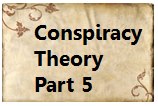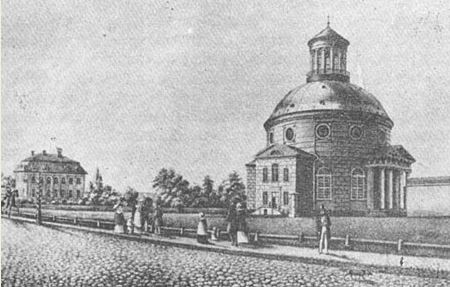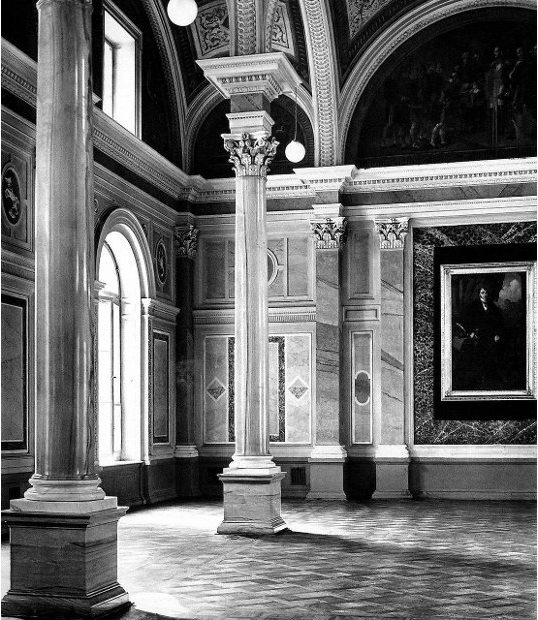|
(PL) Miejsce, w którym obecnie znajduje się gmach Państwowego Muzeum Etnograficznego jest ściśle związane z historią warszawskiego wolnomularstwa. Stał tu Czerwony Dwór zwany też Pałacem Czerwonym zbudowany ok. 1750 r. dla wdowy po gdańskim kupcu Oemichenie. Pierwszą lożą, która miała swoją siedzibę w Czerwonym Dworze był niemiecki warsztat „Złoty Lichtarz”. 2 kwietnia 1802 roku w budynku zapalono światła drugiej loży: „Fryderyk Wilhelm pod Kolumną”. W czasach Księstwa Warszawskiego, nazwę loży zmieniono na „Samarytanin”.
|
|
 |
W budynku okazjonalnie odbywały swoje prace również inne warsztaty napoleońskiej Warszawy. Z całą pewnością do 23 października 1807 roku pracowała tu loża „Prawdziwe Braterstwo”. Nie dziwi też fakt, że w Czerwonym Dworze Stefan Żeromski umieścił akcję przyjęcia do masonerii głównego bohatera „Popiołów” – Rafała Olbromskiego.

Kościół Św. Trójcy z Czerwonym dworem w tle / St. Trinity Church with Red mannor in background
W latach 1853-1858 na miejscu tzw. Czerwonego Dworu powstał na rzucie litery E gmach Towarzystwa Kredytowego Ziemskiego. Projektantami byli Henryk Marconi i Józef Górecki. Przed 150 laty budowla imponowała rozmiarami i bogactwem wystroju wnętrz. Dekoracje malarskie, rzeźbiarskie i jakość architektury sprawiały, że budynek postrzegany był jako reprezentacyjny pałac służący jednej z najważniejszych instytucji finansowych Królestwa Kongresowego.

Wystrój reprezentacyjnej sali posiedzeń nawiązywał m.in. do rzymskich term Karakali.
Pre-war interior which was based on Karakali roman baths

Gmach Towarzystwa częściowo zawalił się w 1939 r. i dalszemu zniszczeniu uległ w 1944 r. Po wojnie odbudowano go na siedzibę Muzeum Etnograficznego wg proj. Czesława Wagnera. Jednak nie odtworzono już wspaniałych wnętrz i wszystkich oficyn. Wyobrażenie o zniszczeniach wojennych daje zachowany element przedwojennej fasady od ulicy Mazowieckiej. Tak przy okazji – to tutaj na ulicy Mazowieckiej w 1894 roku położono pierwszy w Warszawie asfalt.
Droga do skrytki:
Czeka Cię krótki spacerek około gmachu Państwowego Muzeum Etnograficznego. Na jego elewacji można zauważyć pewien motyw z bykiem. Ile razy się powtarza? Odpowiedź to liczba X.
Współrzędne dodatkowego waypointa wskazują na przejście w kamienicy, prowadzące na podwórko. Znajduje się tam ciekawostka, lista "potencjalnych" lokatorów. Liczba lokatorów to liczba Y.
Finał jest pod:
N 52° 14.(X*20-Y+18)
E 021° 00.(Y*20+X*10+71)
W skrytce mała niespodzianka dla pierwszego znalazcy – oryginalny trackable FTF dog tag.
(EN) The place where the National Museum of Ethnography is today is closely connected with the history of Freemasonry in Warsaw. Red Mansion (also called the Red Palace) stood here once. It was built around 1750 for the widow of a merchant Oemichen from Gdansk. The first lodge, which was based here was a German lodge "The Golden Candlestick". In April 2nd, 1802 the light was lit for the second lodge called "Friedrich Wilhelm in Column". At the time of the Duch of Warsaw, the name of the lodge was changed to "Samaritan".
During Napoleonic times other lodges were active there. Certainly, until October 23rd, 1807, it was lodge "True Brotherhood". Not surprisingly, Stefan Żeromski (polish writer) put the Red Manor into the center of the action of initiation to Freemasonry of Raphael Olbromski, his main character in famous book "Ashes".
In the years 1853-1858 new building with E shape layout was built here. Designers were Henryk Górecki and Joseph Marconi. 150 years ago the building was impressive in both - size and wealth of interior design. Decorative painting, sculpture and architecture quality meant that the building was seen as a representative palace used by one of the major financial institutions of the Congress Kingdom.
The building partially collapsed at the beginning of the war in 1939 and it has been further damaged in 1944. After the war it was rebuilt as a base of the Ethnographic Museum according to project of Czeslaw Wagner. However, its great interior was not restored. You can get the idea of the war destruction looking at the part of the original pre-war facade preserved at Mazowiecka street. By the way – it was here - on the Mazowiecka street were the first asphalt in Warsaw was laid on the road in 1894.
The way to cache:
You're in for a short walk around the building of the National Museum of Ethnography. On the elevation you can see a theme with the bull. How many times is it repeated? The answer is the number X.
Coordinates of additonal waypoint shows the gate into the yard. Inside gate is an interesting thing on the wall: The list of tenants (see below picture). Number of "potential" tenants is the number Y.
Final cords are:
N 52° 14.(X*20-Y+18)
E 021° 00.(Y*20+X*10+71)

Lista lokatorów / The list of tenants
Cache is a part of somehow loose series „Conspiracy theory”. Logbook contains the hint for the Bonus cache. The hint is a character (W or E) and distance to one of the freemason’s lodge in Warsaw. Do not forget to write it down!
Cache contains a small surprise for First Finder. Original trackable FTF dog tag.
ATTENTION: This is a very busy place, so be aware of muggles! Weekend or evening is a good idea here.
Congratulations to:
 FTF: seba020
FTF: seba020
 STF: r00t7
STF: r00t7
 TTF: lonely_wolf
TTF: lonely_wolf
